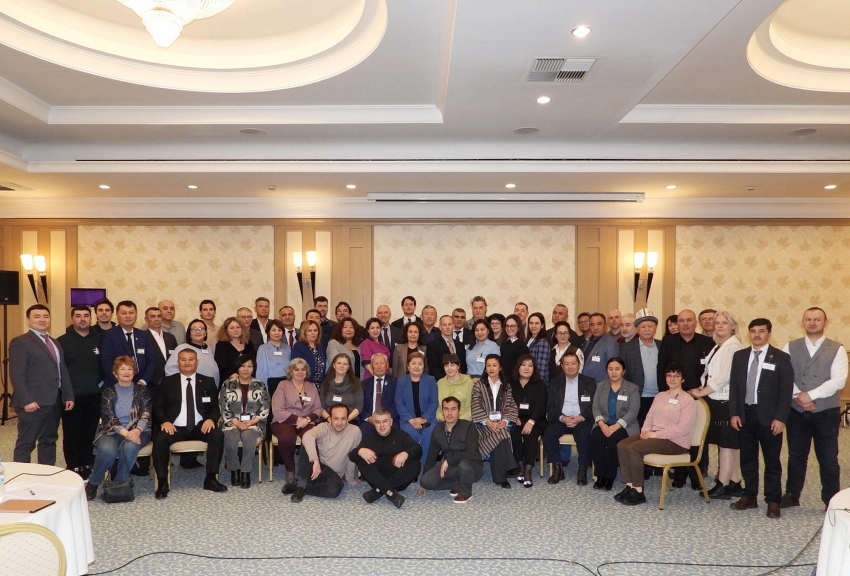KGZ01 Key Biodiversity Area Besh-Aral Nature Reserve

Square: 90 000 hectares.
KBA category: A1, B1
Availability of protected areas: yes, Besh Aral State Reserve.
Species that initiated the designation of KBAs [and other globally threatened species that are present in the KBAs but have not been confirmed to meet the global KBA criteria] Menzbier's Marmot (Marmota menzbieri), Knorring's Hawthorn (Crataegus knorringiana), Tien Shan Hawthorn (Crataegus) tianscbanica), Zinaida's Juno (Juno zenaidae), Camelina's Cinquefoil (Potentilla kamelinii), Minkwitz's Sloth (Thesium minkwitzianum), Eugenia's Primrose (Primula eugeniae), Kaufmann's Tulip (Tulipa kaufmanniana), Snow Leopard (Panthera uncia), Imperial Eagle (Aauila heliacal) , Saker Falcon (Falco cherrual), Tien Shan Birch (Betula tianschanical), Niedzwetzkyana Apple Tree (Malus niedzwetzkyana), Sievers Apple Tree (Malus sieversii), Korzhinsky Pear (Pyrus korshinskyi), Viola allochroa.
Settlements on the territory of the KBA: Besh-Aral village
Adjacent to the territory of the KBA: Angren, Kurulush, Aigyr-Dzhal-1, Dzhany-Bazar-2, Aigyr-Dzhal-4, Korgon-Sai, Kanysh-Kiya, Chakmak-Suu, Bashky-Terek, Ak-Tash, Dzhany-Bazar-1, Chatkal, Aigyr-Jal-5.
Besh-Aral State Reserve
The reserve was organized in 1979 in order to preserve the unique natural complexes of the western part of the Chatkal Valley. Currently, the area of the reserve is 112463.3 hectares . According to the classification of the International Union for Conservation of Nature, it is assigned category Ia - a strict natural reserve.
The purpose of the reserve is to protect the Menzbir marmot, an endemic species included in the Red Book of the Kyrgyz Republic and the International Union for Conservation of Nature (IUCN), as well as the habitats of Greig and Kaufman tulips. The reserve also protects the ecosystems of high-mountain meadows and the unique natural complexes of the Chatkal Valley.
The reserve is located in the southwestern part of the Chatkal Valley, surrounded by the Pskem, Chandalash, Talas and Chatkal ranges at altitudes from 1100 to 4000 m. It is possible to get to it only through the Kara-Buura passes (3305 m) in the Talas Ala-Too and Chapchama ( 2840 m) in the Chatkal ridge.
The Pskem and Chatkal ranges bordering the valley are replete with rocky peaks, deep steep gorges, scree and canyons. The main river of the basin and the Chatkal reserve is one of the largest waterways of the Western Tien Shan, the total length of which is 144 km, has tributaries: the right one - Chandalash with a length of 90 km and the left one - Ters - 40 km, as well as 35 small rivers with a length of 10- 20 km. There is also the picturesque Lake Kara-Toko.
The climate in the reserve is not humid enough with moderately harsh winters and moderately warm summers. The average annual temperature is 7 °C, the average January temperature is –7 °C, July is 21 °C. Characterized by sharp fluctuations in air temperature over the seasons and during the day, with cold winters and warm summers.
The vegetation of the reserve is extremely rich and diverse. Most of the mountain flora of Central Asia, including endemic ones, is concentrated here. 1,500 species of higher plants grow on the territory of the reserve, 30 of which are included in the Red Book of Kyrgyzstan. There are also many medicinal herbs.
The following types of plant communities are distinguished in the reserve: juniper open forest, floodplain and tugai vegetation, tall grass semi-savannas, subalpine meadows, and alpine meadows. Large-grass semi-savannas are communities of large umbrella and other species. Distributed at altitudes up to 3000 m above sea level. Their representatives are: prangos fodder, Ferula Fergana, elecampane high, Astragalus Sievers, etc.
Juniper woodland is found at altitudes up to 2400 m above sea level; in the tree layer, the Zeravshan juniper is dominant; there are numerous various shrubs, among which the main role is played by St. John's spirea, elongated barberry, and honeysuckle. There are also Semenovia abscissus, Eremerus suntanned, Kingshead Severtsova, Elecampane tall, Sievers ostrogal, etc.
The key plants of the reserve's flora include: Lipsky's prangos, hybrid or steppe peony, Tien Shan maikaragana, allochruza paniculata, or paniculata, Severtsov's unhernia, Maksimovich's rhubarb, Wittrock's rhubarb, Kokand morina, Turkestan cornflower, Korolkova's arum, and kingwort.
The fauna of the reserve is represented by 6 orders, the order of predatory mammals is represented by 12 species. The reserve is home to 46 species of mammals, including the following key and indicator species: wild boar, ibex, sand hare, fox, wolf, Tien Shan bear, Turkestan lynx, leopard, stone marten, American mink, Central Asian otter, ermine, weasel, porcupine and marmot Menzbir. A special place in the fauna of the reserve is occupied by an endemic animal of the Western Tien Shan - the Menzbir marmot. According to various estimates, the reserve is home to from 98 to 150 species of birds.
Herpetofauna lives mainly in the lower altitudinal zone and consists of 10 species of reptiles and amphibians, including species such as the steppe agama, desert gologla, Alai gologla, multi-colored foot-and-mouth disease, Nikolsky's foot-and-mouth disease (or Kyrgyz foot-and-mouth disease), gray gecko, yellow-bellied, water snake, patterned snake, Pallas's copperhead.
The ichthyofauna of the reserve includes 12 species including the following species: common marinka, naked osman, “Syr Darya” char, Turkestan catfish, Talas dace, Turkestan gudgeon, scaly osman, Kushakevich char, Terek char, eastern gambusia, acclimatizant and Chatkal sculpin.
The Besh-Aral State Reserve is one of the attractions of Kyrgyzstan. The administration of the reserve is located in the village of Zhany-Bazar (Yangibazar) in the Chatkal region. Tourist routes have been developed in the reserve. Movement around the reserve is only possible on foot or on horseback.
The Besh-Aral Nature Reserve, as well as “Sary-Chelek” and “Padysh-Ata”, are included in the UNESCO World Heritage List.
_________________________________________________________________________________________________________________
1. Based on the Decree of the Government of the Kyrgyz Republic dated August 1, 1979 No. 573
2. Initially, the area of the reserve was 63.2 thousand hectares.










